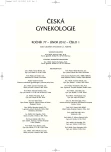Urinary tract infections in women – possibilities of differentiated approach in treatment and prevention
Authors:
J. Kladenský
Authors‘ workplace:
Urologická ambulance, Dům zdraví, Brno
Published in:
Ceska Gynekol 2012; 77(1): 5-9
Category:
Original Article
Overview
Urinary tract infections (UTIs) are among the most urgent health problems for which women in working age see their physician (whether the general practitioner, urologist or gynecologist). The most common manifestation of UTIs in women is acute uncomplicated cystitis the diagnosis and treatment of which is usually straightforward. When selecting an appropriate antimicrobial agent, it is advisable to consider its pharmacokinetics, expected spectrum of efficacy and effect on the vaginal flora. Short-term therapy of three to five days is preferred. In women with recurrent cystitides, it is necessary, in addition to performing comprehensive urological examination to rule out functional or anatomic abnormalities, to perform urine culture and targeted treatment according to sensitivity. The review article presents differentiated options of treatment and prevention of recurrent infections with both antimicrobial agents and regimen measures as well as preparations not included in the group of antimicrobial agents; however, when correctly indicated, their administration may bring long-term relief to these women. The article also deals with complicated infections in women and asymptomatic bacteriuria in elderly women.
Key words:
acute uncomplicated cystitis, recurrent cystitis, complicated urinary tract infection, asymptomatic bacteriuria.
Sources
1. Lipsky, BA. Urinary tract infections in men. Ann Intern Med, 1989, 138–148.
2. Nicolle, LE. Managing recurrent urinary tract infections in women. Womens health (Lond Engl), 2005, 1(1), p. 39–50.
3. Schappert, SM. National ambulatory medical survey: 1990 summary. Advance data from vital and health statistics. No. 213, 1992, Hyattsville, Maryland, USA, National Center for Health Statistics.
4. Kladenský, J., Pacík, D. Infekce dolních močových cest u žen. Prakt Gynekol, 2001, 5, p. 43–45.
5. Bartoníčková, K. Uroinfekce. Praha: Galén, 2000, p. 42–49.
6. Kladenský, J. Infekce dolních močových cest. Diagnóza, 2000, 1, p. 6.
7. Hooton, TM., Stamm, WE. Management of acute uncomplicated urinary tract infections in adults. Med Clin North Am, 1991, 75, p. 339–357.
8. Norrby, SR. Short-term treatment of uncomplicated lower urinary tract infections in women. Rew Infet Dis, 1990, 12, p. 456–467.
9. Gupta, K., Hooton, TM., Roberts, PL., Stamm, WE. Short-course nitrofurantoin for the treatment of acute uncomplicated cystitis in women. Arch Intern Med, 2007, 167(20), p. 2207–2212.
10. Raz, R., Chazan, B., Kennes, Y., et al. Empiric use of trimethoprim-sulfamethoxazole (TMP-SMX) in the treatment of women with uncomplicated urinary tract infections, in a geographical area with a high prevalence of TMP-SMX-resistant uropathogens. Clin Infect Dis, 2002, 34(9), p. 1165–1169.
11. Kladenský, J., Toršová, V., Chmelařová, E. Přínos nifuratelu pro léčbu akutních nekomplikovaných uroinfekcí. Urolog pro praxi, 2006, 7, p. 109–110.
12. Matera, MG. Pharmacologic characteristics of prulifloxacin. Pulmonary Pharmacol Therapeutics, 2006, 19, p. 20–29.
13. Naber, KG., Schito, G., Botto, H., Palou, J., Mazzei, T. Surveillance study in Europe and Brazil on clinical aspects and Antimicrobial Rezistance Epidemiology in Females with Cystitis (ARESC): implications for empiric therapy. Eur Urol, 2008, 54(5), p. 1164–1175.
14. Kladenský, J., Pacík, D. Infekce močových cest u dospělých. Forum Medicinae, 2001, 3, p. 23.
15. Hooton, TM. Reccurent urinary tract infection in women. Int J Antimicrob Agents, 2001, 17(4), p. 259–268.
16. Finger, G., Landau, D. Pathogenesis of urinary tract infections with normal female anatomy. Lancet Infect Dis, 2004, 4(10), p. 631–635.
17. Kladenský, J., Pacík, D., Čermák, A. Nifuratel tbl. v léčbě akutní nekomplikované uroinfekce. Čes Urol, 1998, 5, p. 8–10.
18. Reid, G., Chan, RC., Bruce, AW., Costerton, JW. Prevention of urinary tract infection in rats with an indigenous Lactobacillus casei strain. Infect Immun, 1985, 49(2), p. 320–324.
19. Gupta, K., Chou, M., Howell, A., et al. Cranberry products inhibit adherence of P-fimbria-ted E. coli to ptimary cultured bladder and vaginal epithelial cells. J Urol, 2007, 177(6), p. 2357–2360.
20. Raz, R., Stamm, WE. Protocol of diagnosis of urinary tract infection: Reconsidering the criterion for significant bacte-riuria. Urology, 1988, 32, p. 6–12.
21. Ronald, AR., Patullo, AL. The natural history of urinary infe-ctions in adults. Med Clin North Am, 1991, 75, p. 299–312.
22. Kladenský, J., Pacík, D. Nespecifické infekce dospělých. Postgrad Med, 2000, 2, p. 137.
23. Nicolle, LE., Ronald, AR. Recurrent urinary tract infection in adult women. Diagnosis and treatment. Infect Dis Clin North Am, 1987, 1, p. 793–806.
Labels
Paediatric gynaecology Gynaecology and obstetrics Reproduction medicineArticle was published in
Czech Gynaecology

2012 Issue 1
Most read in this issue
- Is the hysteroscopy the right choice for therapy of placental remnants?
- To conclude knowledge about new colposcopic signs – ridge sign and inner border.
- Risk factors for recurrent disease in borderline ovarian tumors
- The psychosocial needs of newborn children in the context of perinatal care
